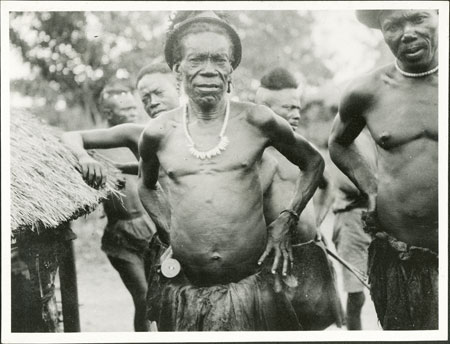Zande men

104 x 78 mm | Print gelatin silver
Condition:
Silver sulphide staining overall [EE 1989]
Date of Print:
Unknown
Previous PRM Number:
EP.A.577
Previous Other Number:
46 3 (+72) [frame 11]
Accession Number:
1998.341.577.2
Description:
A portrait of an elder in Prince Rikita's province (identified as Bagbeyo) wearing a neck ornament (of animal teeth?) and a feathered hat.
To his right is a another man (identified as Nzoropoi), who is partly out of frame.
Beyond are other men, one leaning on the eaves of a hut).
Bagbeyo was apparently commonly reputed to be a nakuangua or nangbisi (a witch).
Photographer:
Edward Evan Evans-Pritchard
Date of Photo:
1927
Region:
[Southern Sudan] Western Equatoria Yambio
Group:
Zande
NamedPerson:
Bagbeyo, Nzoropoi
Notes:
Photographs from the film numbered "46 3" are published in E.
E.
Evans-Pritchard's article "Oracle Magic of the Azande"
Sudan Notes and Records
, Vol.XI, 1928, based upon his first expedition of 1927.
[CM 10/10/2005]
PRM Source:
Edward Evan Evans-Pritchard
Acquired:
Donated 1966
Other Owners:
E. E. Evans-Pritchard Collection
Class:
Physical Anthropology , Ornament , Clothing Headgear
Documentation:
Original catalogue lists in Manuscript Collections. Additional material in related documents files. [CM 27/9/2005]
Primary Documentation:
PRM Accession Records - [1966.27.21] G PROFESSOR E.
E.
EVANS-PRITCHARD; INST.
OF SOCIAL ANTHROPOLOGY, 51 BANBURY RD.
OXFORD - S.
SUDAN, AZANDE TRIBE.
Box of negatives in envelopes.
Nos.
1 - 400
Added Accession Book Entry - [In pencil in column] Catalogue room.
[1966.27.23] G PROFESSOR E. E. EVANS-PRITCHARD; INST. OF SOCIAL ANTHROPOLOGY, 51 BANBURY RD. OXFORD - S. SUDAN, AZANDE TRIBE. Box of prints in envelopes, nos. 1 - 400 (prints of negatives in 1966.27.21)
Manual Catalogues [typewritten, entitled "Zande Photographs (E-P)"] - 577. Men (subjects of Rikita -- Bagbeyo and Nzoropoi). 46/3 (+72)
Notes on card mount m/s pencil - "SSS overall 8.89"
Added Accession Book Entry - [In pencil in column] Catalogue room.
[1966.27.23] G PROFESSOR E. E. EVANS-PRITCHARD; INST. OF SOCIAL ANTHROPOLOGY, 51 BANBURY RD. OXFORD - S. SUDAN, AZANDE TRIBE. Box of prints in envelopes, nos. 1 - 400 (prints of negatives in 1966.27.21)
Manual Catalogues [typewritten, entitled "Zande Photographs (E-P)"] - 577. Men (subjects of Rikita -- Bagbeyo and Nzoropoi). 46/3 (+72)
Notes on card mount m/s pencil - "SSS overall 8.89"
Other Information:
In Witchcraft, Oracles and Magic Among the Azande (OUP 1937, page 132) E.
E.
Evans-Pritchard states that 'The manner in which anything that a suspected witch may say is interpreted in a different sense from the one he intended to give to his words is shown in the case of an old man, called Bagbeyo, whom I used to meet sometimes in Rikita's province.
Everybody told me that he was a witch, and the number of hens' wings he received seemed to be regarded as a big joke.
When I asked him why he was always accused of witchcraft he replied that it was because he possessed powerful magic to protect his gardens.
When people came to injure his crops with their witchcraft the magic kille them, and then his neighbours said that he was responsible for their deaths, whereas their own witchcraft was the cause.' It is possible that the two terms for witch, nakuangua and nangbisi have the following meanings: kua seems to relate to the verb to gather, break, crumble, wrinkle etc., and ngua is the term for tree, plant and medicine.
and so the word nakuangua would mean 'someone that gathers medicines' i.e.
for the purpose of witchcraft; ngbisi is translated by Canon & Mrs E.C.
Gore in their Zande and English Dictionary (London, The Sheldon Press 1952 [1931], page 105) as a 'voice in the throat (only of a woman who has communicated with spirits'.
Nangbisi could therefore directly refer to female witchcraft or more widely to someone who mutters invocations or who communicates with spirits, in the performance of witchcraft.
[Chris Morton 24/11/2003]
Recorder:
Christopher Morton 24/11/2003 [Southern Sudan Project]

